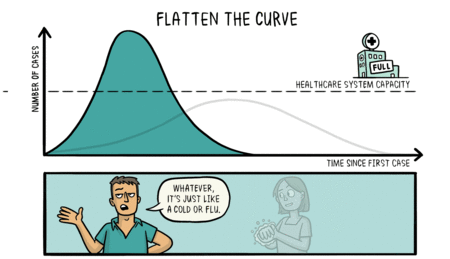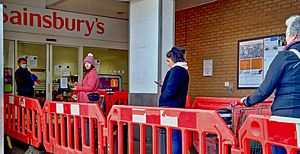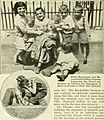Social distancing facts for kids
Social distancing means taking steps to stop or slow down how fast a contagious disease spreads. It's about reducing the chances that people who are sick will come into contact with people who are healthy. This helps to lower the number of people who get sick and, in the end, saves lives.
Social distancing works best for illnesses that spread through:
- Droplets (like from a cough or sneeze).
- Direct touch (like shaking hands).
- Indirect touch (like touching a surface a sick person has touched, called a fomite).
- Air (if tiny germs can float in the air for a while).
During the COVID-19 pandemic, the World Health Organization (WHO) suggested calling it "physical distancing" instead of "social distancing." This is because the goal is to keep a physical space between people to stop germs. You can still be social and connected with friends and family using technology!
Social distancing might not work as well for diseases that spread mainly through dirty water, food, or by insects like mosquitoes.
Sometimes, social distancing can make people feel lonely. It can also make it harder to work or enjoy being with others.
In the past, places like leper colonies were used to keep people with diseases like leprosy separate. This was a way of social distancing before doctors understood how these diseases spread or how to treat them.
Contents
How Does Social Distancing Work?
Social distancing uses different methods to control the spread of illnesses. Here are some examples:
- Closing Schools: Schools might close, and students learn from home online.
- Closing Workplaces: Some businesses that aren't "essential" (like hospitals or grocery stores) might close.
- Isolation: This is when a sick person stays away from others.
- Quarantine: This is when someone who might have been exposed to a disease stays away from others, even if they don't feel sick yet.
- Canceling Large Events: Big gatherings like sports games, concerts, or movies might be called off.
- Limiting Public Transport: Buses, trains, and subways might run less often or carry fewer people.
- Closing Fun Places: Community pools, youth clubs, and gyms might close.
- Staying Home More: People might limit face-to-face meetings, do business by phone or online, and avoid crowded public places.
- New Greetings: Instead of a handshake, people might do an "elbow bump." The "Dracula sneeze" (sneezing into your elbow) also helps stop germs.
Is Social Distancing Effective?

Studies show that social distancing measures work best when they are started quickly and followed strictly.
During the 1918 flu pandemic, two US cities, Philadelphia and St. Louis, used social distancing. Philadelphia waited five days to start, and the flu spread much faster there. St. Louis acted right away, which helped slow down the spread a lot.
Research found that if these measures were started too late or stopped too early, they didn't help as much. Some cities saw a second wave of sickness after they stopped social distancing too soon.
School Closures
Closing schools helped reduce sickness from the Asian Flu by 90% in 1957-58. It also helped control the flu in the US between 2004 and 2008 by up to 50%. During the 2009 flu epidemic in Mexico, closing schools and other measures lowered flu spread by 29% to 37%.
Workplace Closures
Studies suggest that if 10% of workplaces close, the spread of infection slows down a bit. If 33% of workplaces close, the number of people who get sick drops even more, and the peak of the illness is delayed by a week.
Quarantine for Contacts
During the 2003 SARS outbreak in Singapore, about 8,000 people had to stay home in quarantine. Another 4,300 had to check for symptoms daily and call health officials. Even though only 58 of these people got SARS, officials believed this helped stop the disease from spreading further.
Protecting a Community
In 1995, a "cordon sanitaire" (a strict barrier) was used to control an Ebola virus outbreak in Kikwit, Zaire. The town was surrounded by troops, and flights were stopped. Inside Kikwit, health teams created more barriers to separate sick people and burial areas from everyone else. This successfully stopped the infection.
During the 1918 flu epidemic, the town of Gunnison, Colorado isolated itself for two months. They blocked all roads and warned train passengers not to get off the train. Because of this, no one in Gunnison died from the flu during that time. Other communities did similar things.
Canceling Large Gatherings
It's not always clear if large gatherings definitely spread diseases more. But some events might increase the risk of flu spread. They can also bring new types of germs into an area. During the 1918 flu pandemic, military parades in Philadelphia and Boston might have spread the disease by mixing sick sailors with large crowds. Stopping large gatherings, along with other social distancing steps, can help reduce spread.
Travel Restrictions
Stopping travel between places usually only delays an illness by a few weeks, unless almost everyone follows the rules. Checking people at airports didn't stop the spread of SARS in 2003. However, strict border controls between Austria and the Ottoman Empire from 1770 to 1871 were effective against the bubonic plague. Austria had no major plague outbreaks after these controls, while the Ottoman Empire continued to have them.
A study in March 2020 found that travel bans for COVID-19 only slow down the international spread when combined with social distancing. The study showed that the travel ban in Wuhan, China, only delayed the spread within China by a few days. However, it did reduce international cases by up to 80%. One reason travel bans are less effective is that many people with COVID-19 don't show symptoms early on.
Challenges of Social Distancing
Social distancing can have some downsides. It can slow down the economy and make people feel lonely. It can also reduce how much work gets done and take away the good things that come from being with other people. In some countries, it's harder to check on everyone's health because they don't have as much technology or protective gear.
Images for kids
-
Muslims in Indonesia pray in congregation while imposing to strict physical-distancing protocols during the COVID-19 pandemic. During the pandemic, Mosques in Indonesia has also removed the indoor rugs and has ordered worshipers to bring their own personal prayer rugs to prevent the spreading of the virus. Some mosques which are located in the most infected regions even are ordered to be closed for worship
-
Urinals adjusted in a way close contacts are less likely
-
The Lazzaretto of Ancona was constructed in the 18th century on an artificial island to serve as a quarantine station and leprosarium for the port town of Ancona, Italy.
-
Passenger without mask being refused boarding of a streetcar amid 1918 flu pandemic. (Seattle, Washington, 1918)
See also
 In Spanish: Distanciamiento físico para niños
In Spanish: Distanciamiento físico para niños













